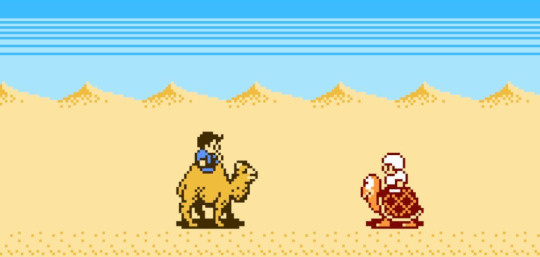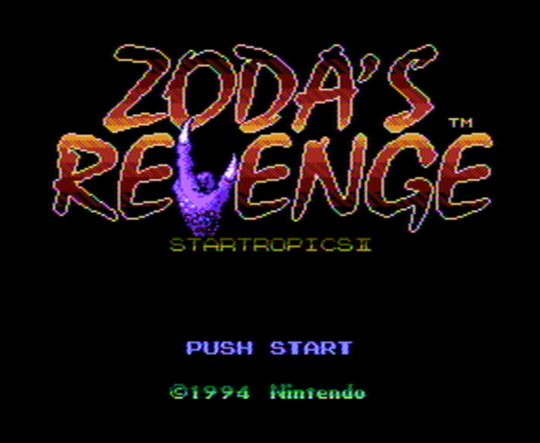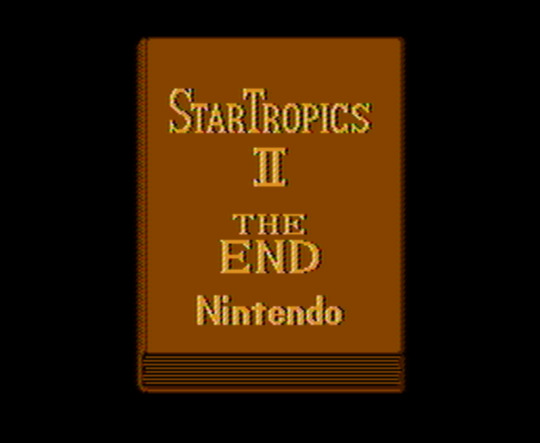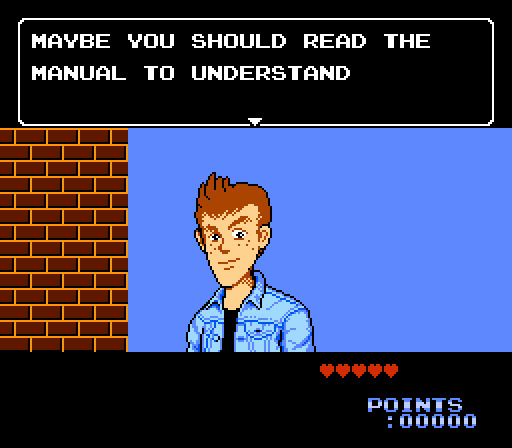#Zoda’s Revenge: StarTropics II
Photo

In Zoda’s Revenge: StarTropics II for the NES, an NPC is shown riding on a red Koopa Troopa.
Main Blog | Twitter | Patreon | Source: twitter.com user “reinodocogumelo”
168 notes
·
View notes
Text
List of Video Games Turning 30 Years Old in 2024
Aggressors of Dark Kombat (what if Mortal Kombat was made by the KoF devs?)
Alone in the Dark 2
Art of Fighting 2
Beneath a Steel Sky (a highly influential point and click adventure game from the same team that would go on to make Broken Sword)
Blackthorne (a 2D platformer made by Blizzard)
Breath of Fire (the 1st one)
Bubsy 2
Bubsy in Fractured Furry Tales
Bust-a-Move (known as "Puzzle Bobble" in Japan)
Castlevania: Bloodlines
Contra: Hard Corps (the first game in the series to have multiple endings)
Cosmology of Kyoto
The Death and Return of Superman (a side scrolling beat 'em up made by Blizzard)
Demon's Crest
Donkey Kong (the Game boy version of the arcade original)
Donkey Kong Country
Doom II: Hell on Earth
Double Dragon V: The Shadow Falls (as opposed to a beat ‘em up like the other four games were, this one was a fighting game)
Dungeons & Dragons: Tower of Doom
Dynamite Headdy
Earthworm Jim (with music from Tommy Tallarico. His mother is very proud.)
Ecco: The Tides of Time
The Elder Scrolls Arena (the very 1st one)
Final Fantasy VI
Fire Emblem: Mystery of the Emblem (the 3rd one)
Ghoul Patrol (the sequel to "Zombies Ate My Neighbors")
Heretic
The Horde (a hybrid action/strategy game made by Toys for Bob, who are known nowadays for making Crash Bandicoot 4: It’s About Time)
Illusion of Gaia
Indiana Jones' Greatest Adventures
Killer Instinct
The King of Fighters '94
King's Quest VII: The Princeless Bride
Live a Live (the original version, which went unreleased in North America. We wouldn’t get this game until the HD-2D remake 28 years later)
Majin Tensei (a strategy spin-off of the greater Shin Megami Tensei franchise)
Marathon (one of the earliest games made by Bungie)
Mega Man 6
Mega Man Soccer
Mega Man V (on the Game Boy)
Mega Man X
Mortal Kombat II
The Need for Speed (the very 1st one)
Pac-Man 2: The New Adventures (as an empath, seeing Pac-Man in pain makes me feel sick)
Pitfall: The Mayan Adventure
Pocky & Rocky 2
Policenauts (a visual novel and one of the earlier works from Hideo Kojima)
Rise of the Robots (often considered one of the worst fighting games ever made)
Robotrek
Samurai Shodown II
Shadowrun (the Sega Genesis version)
Shaq Fu (also often considered one of the worst fighting games ever made)
Shin Megami Tensei II (which, to this day, has never been officially released outside of Japan)
Shin Megami Tensei If... (also never officially released outside of Japan)
Shining Force II
Sonic the Hedgehog 3 (just in time for the third movie)
Sparkster
Spider-Man and Venom: Maximum Carnage
Star Wars: TIE Fighter
Streets of Rage 3
Super Adventure Island II
Super Metroid
Super Punch-Out!!
Super Star Wars: Return of the Jedi
Super Street Fighter II: The New Challengers (this release saw the first playable appearances of T. Hawk, Fei Long, Dee Jay, and Cammy)
Super Street Fighter II Turbo (saw the series’ first secret character, Akuma)
System Shock (a remake came out very recently. It's quite good!)
Ultima VIII: Pagan
Warcraft: Orcs & Humans (the very 1st one)
Wario Land: Super Mario Land 3
X-COM: UFO Defense (the 1st game in the series)
Zoda's Revenge: StarTropics II (one of the last first-party releases for the NES)
Zool 2
#snk#alone in the dark#art of fighting#beneath a steel sky#blackthorne#breath of fire#bubsy bobcat#bubsy#bust a move#puzzle bobble#castlevania#contra#superman#blizzard#demons crest#donkey kong#donkey kong country#doom#double dragon#dungeons and dragons#earthworm jim#tommy tallarico#ecco the dolphin#the elder scrolls#final fantasy#final fantasy 6#fire emblem#fire emblem mystery of the emblem#zombies ate my neighbors#heretic
1 note
·
View note
Video
youtube
Zoda's Revenge StarTropics II | NES LongPlay [012]
Star Tropics II: Zoda’s Revenge shares many traits with StarTropics, and unfortunately it suffers badly for the comparison. Though it is an entertaining game that requires both quick reflexes and logical thinking, it feels like a cheap rehash, bankrupt of innovation or creativity; it comes across as a weak attempt to wring a little more money out of the NES in its twilight years. It’s worth a play for fans of StarTropics – just don’t expect to be blown away by it.
0 notes
Link
#PrinceWatercress#HCBailly#Zoda's Revenge: StarTropics II#gaming#retrogaming#let's play#NES#Nintendo#Nintendo Entertainment System#part 14#Blog#Blogger#Blogspot
2 notes
·
View notes
Text
Backblog #14 - Zoda's Revenge: Star Tropics II (NES)

Of course, my followup to StarTropics is its one and only sequel, Zoda's Revenge: StarTropics II. Developed by Nintendo R&D3 and published by Nintendo in March of 1994 in North America only for the Nintendo Entertainment System, StarTropics II is among the final games released on the console, along with the likes of Wario’s Woods and Adventure Island IV. Like the first game, it was never released in Japan, even for the Virtual Console releases. Also like the first game, it is an action-adventure game, but this one arguably trends even more toward the action side of the scale.
The story picks up very shortly after the end of the first game, with Mike back in his hometown of Seattle. The ending of the first game reveals that the three MacGuffins that Zoda was after contained a time frozen group of children of the alien race he sought to exterminate, the Argonians, including their princess, Mica. At the beginning of the the second game, Mike is telepathically contacted by Mica and she gives him a clue that she received from her father, Hirocon, in a dream that may help solve the cipher that was etched into the escape pod they were sent away in. Mike immediately goes to see his uncle, the archaeologist from the first game, Dr. Jones, and relays the clue to him. After they solve the cipher, Mike reads it aloud and is flung by its power into the distant past, into the Stone Ages.
Here, Mike is able to help a group of friendly cavemen he meets by defeating a gigantic beast that had been plotting to eat their children, and finds a strange object shaped like a Tetris piece in the beast’s cave. Mica manages to contact Mike again and informs him that the object is called is called a tetrad (or a “block” in the Virtual Console releases, which is a change that certainly makes more sense than calling a yo-yo an “island star”). She postulates that Hirocon probably intended for Mike to seek all seven of them out and that they are hidden across the Earth throughout time.
And this is the basic structure of them game. Each chapter (nine in total including the first one which just comprises the intro cutscene with Mike in Seattle) has Mike jumping to a different time, fighting his way through one to two dungeons, and retrieving a tetrad. The time periods represented range from Ancient Egypt to the Wild West to Renaissance Italy. You also meet a handful of historical (and one fictional and two legendary) figures in the various time periods: Cleopatra, Sherlock Holmes, Leonardo da Vinci, King Arthur, and Merlin, who all help to guide you through your quest. At some point you figure out that there is more than one Zoda (Zoda-X, Zoda-Y, and Zoda-Z) and they are all competing with you to find the tetrads.
The game also isn’t without the lighthearted charm that was present in the first game. The interactions with the historical figures are often comical, with Cleopatra refusing to help until you find out what’s taking her pizza delivery so long (turns out the delivery man was using a koopa instead of a camel) and Leonardo da Vinci changing the Mona Lisa’s hairstyle to one that Mike comments is “radical” in extremely 90s fashion. There’s also, of course, the infamous Cactus Dance craze that has been sweeping all the nations of the world since this game was released and continues to do so to this day.
The idea of traveling to different time period setpieces is one that I like a lot in concept, but I don’t think it’s quite used to its full potential here. Some of the dungeons and bosses feel a little bit disconnected from their time periods. The dungeons in Renaissance Italy could really just be any castle anywhere and I really don’t know what a rock-throwing cyclops has to do with the Wild West. The worst offender for this is probably the Sherlock Holmes-era one in London. This chapter would be a great set-up for a segment that’s more focused on a longer travel stage rather than the action stages, maybe with a very simple mystery for the player to solve. But instead of anything like that, most of it is two very irritating sewer levels.
However, the setpieces are mostly fine outside of this and they do give the dungeons that little bit more of character I thought they needed in the first game. That, and the game ends on a very strong note, with you returning to present day C-Island to delve into the first dungeon of the first game and fight a skeletal version of its first boss, followed by a boss rush leading to Zoda-Z. It’s a pretty cool moment and I like it a lot when games do things like that in general (Dragon Quests II and III do this, for example). The only damper on this is that I don’t care too much for the remix of the dungeon music from the first game that is used here. It’s a lot more downbeat and doesn’t sound nearly as exciting as it probably should.
The gameplay of each individual chapter is pretty much structured the same as the first game with travel stages where you adventure around and find your way to action stages where you fight your way through dungeons. The travel stages feel a bit more pushed to the side in this one, however, with more of them feeling like straight shots to the action stage. And more often than not, the the travel stage bridging the first and second actions stages really are just short hallways, becoming more like checkpoints. One somewhat large change to the travel stages is that there are a few chapters that have areas where you will fall into a pit leading to a random miniature action stage in the middle of a travel stage. This comes to a head in the Renaissance Italy chapter, which is full of this.
The action stages themselves feel very similar to the first game though, being mostly linear gauntlets, and are often pretty challenging. Their design in general feels more streamlined and includes some new elements. There is now verticality to their design, or as much are there can be in an overhead game. You sometimes have to jump up a couple of levels higher to cross a series of gaps or are forced to come back into a room from a different, higher up, entrance in order to proceed. There’s also added elements such as moving platforms (more on those below) and arrow tiles that either move you slightly or sometimes send you hurtling in the direction of the arrow. There is also even less puzzles to solve now. The action stages really live up to their name here.
Unlike the first game, instead of the yo-yo you have that gets upgraded over the course of the game, Mike is armed with a regular weapon (initially a stone axe, then a bronze dagger, then a katana) that he just throws infinite amounts of and a psychic shock wave that upgrades twice over the course of the game. The shock waves are typically the better choice due to being faster and having longer range and even feels more like the yo-yo and its upgrades. Although, neither of them have as much charm as using a yo-yo as a weapon, I feel. There also isn’t as much of a variety of subweapons as in the first game, but I guess this is really because you usually have two primary weapons.
The biggest and most frustrating change is, ironically, the fact that the controls are not as rigid as they were in the first game. Unlike the first game, the movement is no longer tile-based, with Mike able to move pixel-by-pixel and even move diagonally. He generally feels a lot swifter and it’s easier to out-maneuver enemies. Which all sounds great, until you factor in the jumping. The jumping is also a lot less rigid and you are able to adjust jumps in midair, which somehow makes the platforming (which there is a larger emphasis on here) much more irritating to do. Overhead platforming is already a bit of a pain to judge correctly compared to side-scrolling and the first game gets around this by making it all tile-based. As long as you’re actually jumping to a tile you can reach and the tile doesn’t disappear, you’re fine.
But here that’s not exactly the case, and the collision for this feels a lot more sensitive than it needs to be. Oftentimes, the falling to your death animation appears to be overlapping the platform you were attempting to jump to. At one point I even slipped through a one-pixel gap between a moving platform and the floor because I guess even that much of a pit was enough for Mike to fall into. The trick to get around this (for non-moving platform jumps at least) is to just completely ignore the fact that you can adjust at all. If you press a direction and jump, Mike still jumps across a tile just like the first game. Any aerial adjustments that happen after this can often be fatal and there’s no point really to making them. But moving platforms throw a wrench into this since you might actually need to adjust in order to account for their movement. Additionally, they’re the only platforms in the game you’re able to walk off of to your death, compounding the annoyance that comes from them.
Graphically, the game has more or less the same look as the first one, but generally the sprites look a little bit better, especially in the travel stages, which was graphically the weakest part of the first game. And Mike now even sports a denim jacket instead of just a blue shirt, for maximum 90s aesthetic. The CGs used during cutscenes have an identical artstyle to the first game, which is fine because they did and still do look great. Also, the gripe I had about the dungeons mostly looking the same in the first game is mostly solved here, as I mentioned above. There’s also a lot more of a variety of music which is generally pretty good, outside of the somewhat lame remixes of music from the first game in the final chapter.
There’s often a debate on whether or not this game or the first one is better, and I think it’s probably pretty clear which side of that debate I’m on. I ultimately prefer the first game and don’t think this one fully stacks up to it. But this is still worth checking out. It’s also worth noting, going back to the Zelda comparison I made when talking about the first game, that this game postdates both A Link to the Past and Link’s Awakening and certainly feels nothing like either of those games. Even if the first game could be considered vaguely a Zelda clone, this one didn’t follow through on that at all and continued to just go more in the direction the first game established.
Unfortunately, this pretty much closes the book on this series for me (not counting the StarTropics III fangame which probably won’t ever be finished anyway). It’s most likely that the game’s very late inclusion in the NES lineup is what ultimately contributed to the downfall of both it and the series as a whole, which is a shame because I do like these games overall. Oh well. The next thing on my list is, as of it being translated at the end of this August, Metal Slader Glory. And it being an early visual novel, of course means I’m going to do another little genre detour. So, the next game I’m actually going to play is most likely going to be Portopia Renzoku Satsujin Jiken. Until then, take it easy~

#text post#backblog#backlog#backloggery#video games#startropics#zoda's revenge: startropics ii#nintendo#nintendo entertainment system#action-adventure
2 notes
·
View notes
Photo

History of StarTropics – Gaming Historian Gaming Historian goes over the history of the StarTropics series, a Nintendo franchise that both began & ended on the NES. StarTropics was Nintendo's attempt ... source
#Gaming Historian#Genyo Takeda#History of StarTropics#Mike Jones#NES#nintendo#Nintendo Entertainment System#Ru0026D3#StarTropics#StarTropics History#StarTropics II#StarTropics Review#Video Game History#Zoda#Zoda&039;s Revenge Review
0 notes
Text
FGC #441 Zoda's Revenge: StarTropics II
FGC #441 Zoda’s Revenge: StarTropics II
The original StarTropics game was an action/RPG hybrid that saw young Mike Jones venture through some ill-defined “South Seas” Caribbean-esque tropical venues. Mike traversed caves, spoke to parrots, and eventually discovered the source of all of his woes were mysterious aliens. The aliens are well established as antagonists from early on, though (StarTropics), so they’re not completely out of…
View On WordPress
#digital pictures#fgc#keep beach city weird#nintendo#nintendo entertainment system#one player#pigs is pigs#sherlock holmes#skeleton dance#skeletons#spooky#StarTropics#tetris#thar be dragons#tmnt#wii#wiiu
0 notes
Link
#PrinceWatercress#Mega Man 6#Zoda's Revenge: StarTropics II#NES#Nintendo#Nintendo Entertainment System#commercial#Blog#Blogger#Blogspot
2 notes
·
View notes
Link
#PrinceWatercress#let's play#Zoda's Revenge: StarTropics II#gaming#retrogaming#NES#Nintendo#Nintendo Entertainment System#part 2#Blog#Blogger#Blogspot
2 notes
·
View notes
Link
#PrinceWatercress#HCBailly#Zoda's Revenge: StarTropics II#gaming#retrogaming#NES#Nintendo#Nintendo Entertainment System#part 15#Blog#Blogger#Blogspot
1 note
·
View note
Link
#PrinceWatercress#HCBailly#Zoda's Revenge: StarTropics II#gaming#retrogaming#let's play#NES#Nintendo#Nintendo Entertainment System#part 13#Blog#Blogger#Blogspot
1 note
·
View note
Link
#PrinceWatercress#HCBailly#Zoda's Revenge: StarTropics II#gaming#retrogaming#let's play#NES#Nintendo#Nintendo Entertainment System#part 12#Blog#Blogger#Blogspot
1 note
·
View note
Link
#PrinceWatercress#HCBailly#Zoda's Revenge: StarTropics II#gaming#retrogaming#NES#Nintendo#Nintendo Entertainment System#part 11#Blog#Blogger#Blogspot
1 note
·
View note
